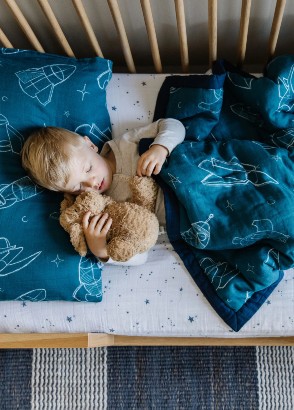Once your toddler is out of a cot, gentle sleep training techniques definitely work best.
If you use cry it out or controlled crying, your toddler will be constantly getting out of bed, screaming at the door etc!
However if you consistently use our gentle sleep techniques, you will gradually teach your toddler to sleep independently and settle easily...without the screaming toddler tantrums!
Often toddler sleep battles result from separation anxiety, so being really tough on your toddler makes matters worse. if all the toddler wants is a bit more time with you or some extra reassurance, then these techniques are especially relevant.
These techniques are suitable for toddlers who have never been great sleepers and for those who have had a turn for the worse in otherwise good sleep habits.
Make sure that the following basics are covered before you start using the sleep training techniques.
Gently Encourage your Toddler to Sleep
Toddler sleep basics
-
NO BOTTLES in the night!!! You need to stop using feeds to get your toddler back to sleep...they will just keep waking otherwise.
-
Warm enough all night, ie sleeping in a toddler bag, sleepsuit or sufficient clothing
-
Has a nightlight on all night
-
Has white noise or music on repeat all night
-
Has a good bedtime routine, at least 45 minutes allowed for bath/cuddles/stories etc...no rushing from mum and dad!
-
No TV or other electronic stuff between dinner and bedtime
-
No rough or physical play between dinner and bedtime
-
Has a cuddly, comforter or special toy to cuddle all night
- Parents are committed to consistently tackling the sleep problem, and won't change their mind at 2am!!!
Gentle techniques
Gradual withdrawal method
The idea with this technique is that you give your toddler all the reassurance and company they need at bedtime to fall asleep. Perfect for kids who like mum or dad with them at bedtime, like to visit during the night or who are prone to getting out of bed repeatedly.
Then over a few nights, you will SLOWLY wean your toddler off needing you there as they fall asleep. Done slowly at the pace your toddler is comfortable with, this is an extremely effective technique.
Please note this doesn't work if you try to rush your child or you don't stay with them when you said you would...build your child's confidence that they can sleep independently but don't undermine their trust in you following through with what you said (ie no trying to sneak out before they are asleep if you said you would stay).
If your child wakes crying or comes in to visit you, then continue with the technique the same as you would at bedtime. It won't work if you let your child into your bed sometimes.....
Step 1
Start your bedtime routine by reading your toddler 3 stories. It can help to use one with a bedtime theme. My favourites are ‘The Sleep Book’ by Dr Seuss, ‘Kiss Goodnight Sam’ and ‘Go to Sleep Doodlehead’.
Step 2
Make the self settling process easier for you and your toddler by using some effective sleep tools. A night-light, relaxing bedtime music and a comfort item such as a blankie can all assist your toddler to sleep easier and don’t require you during the night.
If your toddler uses a dummy, give them several and tell them you won’t be putting the dummy in for them or finding it during the night!
Step 3
On the first night start by reassuring your child that you will stay with them until they fall asleep. This will help your child relax and they are more likely to stay in bed if they know you really will stay with them.
Step 4
Then either lie in bed with your toddler or sit next to them until they fall asleep. Continue with step 4 for the next couple of nights before moving to sitting on the end of the bed or on a chair next to the bed.
Step 5
Over the next week, gradually move the chair further away from your toddler and stay in the room as they fall asleep. By now you will notice they are settling down easier and falling asleep faster.
Step 6
Kiss your toddler good night at bedtime, leave their sleep music on repeat and leave them to use their new self settling skills to fall asleep without your presence.
'Pop-outs' technique
This technique is ideal for kids who are making great progress with their sleep, or ones who are usually good sleepers and are just going through a bit of a phase of needing extra reassurance.
The idea is to sit a while with them, as they are getting ready to fall asleep, then you 'pop-out' of the room for a VERY short time, just 30 seconds max.
Then return and continue to sit as they fall asleep. As you gradually increase the time you are out of the room, you are giving your toddler an opportunity to fall asleep independently....while knowing you aren't far away.
Each time you 'pop-out', say something simple like 'Mum has to pop out for a drink of water, I'll be back in a sec'. Pop out quickly then return.
You may want to gradually increase the time you pop out for, until you are giving your toddler several minutes of opportunity to fall asleep by themself.
Other good lines for popping out:
-
I just need to check on the baby, I'll be back in a sec
-
Mum needs to go to the loo, I'll be back in a minute
-
I'll just turn the washing on and I'll be back to sit with you
You get the idea - quick and believable! You may need to also say something like 'Please stay in bed while I pop out. If you get out, I may not be able to keep sitting with you'. Then provide lots of positive reinforcement for staying in bed eg 'Thanks for staying in bed while I popped out, what a good boy you are for settling down like that'.
Camping in with your toddler
If your toddler constantly wakes in the night, has been sleeping in your bed/room or visits in the night, you may find 'camping' in your toddler's room a good transitional stage.
Basically it means you sleep in your toddler's room, on a mattress near their bed. So your toddler has the reassurance of you being close by, all night, but they are getting used to sleeping in their own bed all night.
It can be easier for you, in that you won't be constantly getting up and taking your child back to their bed...and also a good option if you find you are a softy in the night and just let your toddler sleep in your bed!
Explain to your toddler that you are going to camp in with them for a few nights, while they get used to sleeping in their own bed. Avoid giving the impression you are moving in permanently!
Once they are settling easier and generally sleeping through in their own bed, you can start to move them towards sleeping without you in there all night. Choose one of the techniques above (gentle withdrawal or pop-outs' to wean your child off needing you there when they fall asleep.
Positive reinforcement
You may want to combine these above techniques with some positive reinforcement, such as small rewards or a sticker chart.
Keep it age appropriate, achievable and realistic. For example, a small $2 shop toy each morning for 3 mornings after settling well at bedtime is a suitable reward. having to be perfect at bedtime for 14 days in a row is far too much for a toddler to comprehend and will not help your sleep training!
We find that children need to be at least 3 years old before sticker charts start to be effective.
With younger children, actual simple rewards given in the morning work better.
Some examples of simple rewards include:
-
Little Matchbox type car
-
Page of stickers
-
Lollipop (or other healthier option!)
-
Money to spend at $2 shop for older toddlers/preschoolers
-
Small box of crayons etc
-
Small items for family/dress-up play
More information
If you need more detailed information about gentle sleep training for toddlers:





















